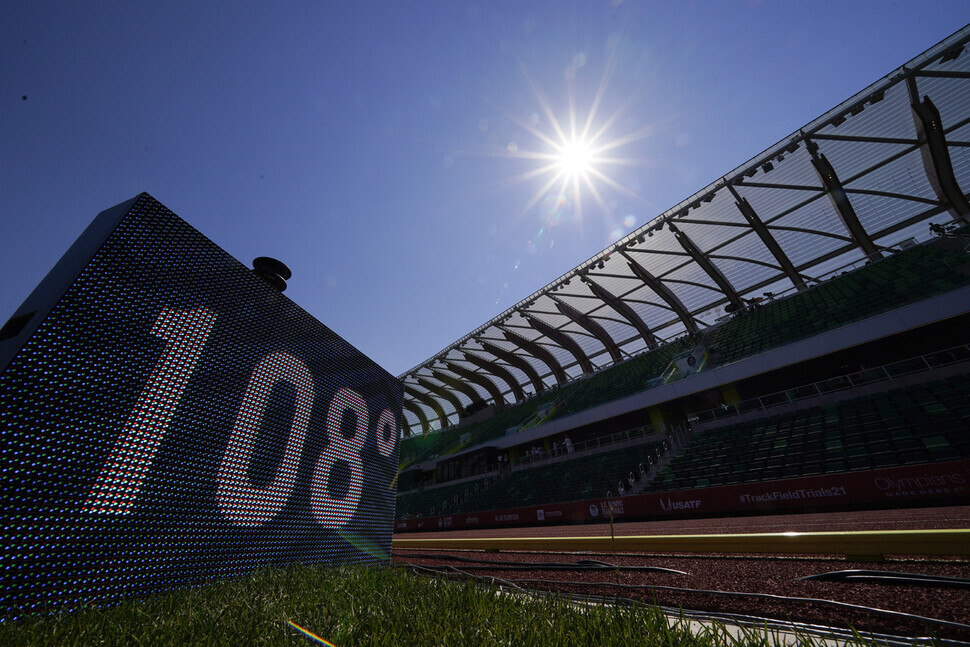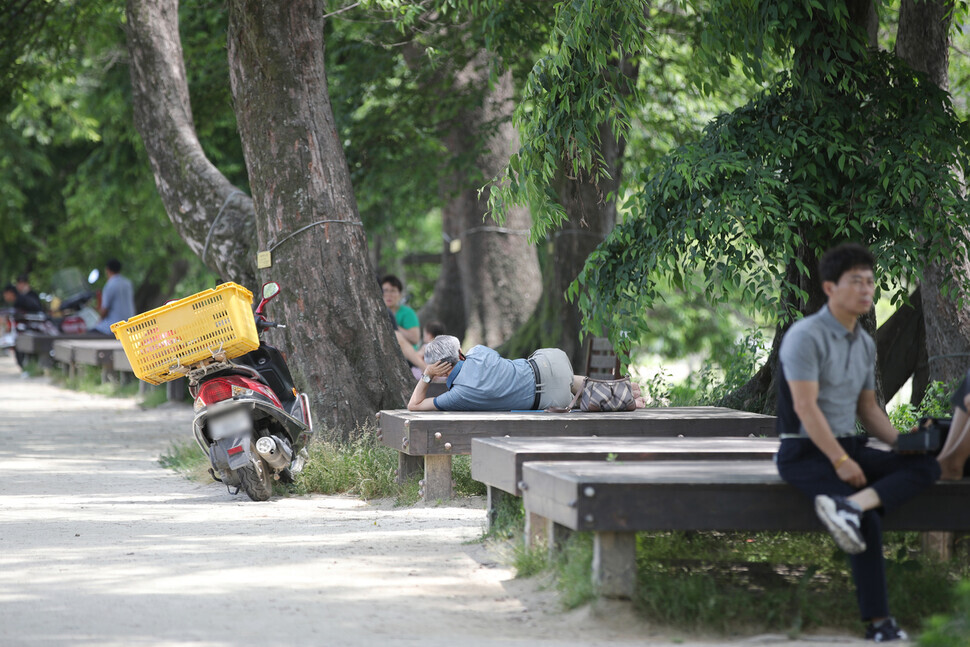hankyoreh
Links to other country sites 다른 나라 사이트 링크
“Heat dome” causing extreme temperatures in North American can hit Korean Peninsula

Extreme temperatures along the Pacific coast in western North America continue unabated, with a death toll that has already reached the hundreds.
A heatwave warning was also issued Thursday for Seoul and other locations in South Korea, which is also situated in the Northern Hemisphere. Weather experts are not ruling out the possibility that South Korea could see the same kind of “heat dome” phenomenon responsible for the scorching temperatures in North America.
Instability resulting from atmospheric stagnation often causes rain showers. According to the experts, South Korea could experience a similar heatwave to the one in North America if the hot and humid North Pacific High remains stuck in the air over the Korean Peninsula.
Atmospheric stagnation, or “blocking,” is the phenomenon responsible for both the North American heatwave and the late rainy season on the Korean Peninsula. Blocking means that the flow of air has been literally blocked so that it remains stuck in one place.

The “heat dome” phenomenon likewise results from a hot air mass being blocked.
“Blocking can happen at any time. What’s distinctive about the North American heat wave is how long it has persisted,” said Lee Hyun-soo, manager of climate prediction for the Korea Meteorological Administration (KMA).
“This is seen as being related to climate change, in that it’s difficult to predict when or where it might occur,” he said.
With the melting of glaciers around the Arctic and other phenomena associated with intensifying global warming, the jet stream that serves to contain cold polar air has weakened. With the weakening of that stream’s ability to move air in an east-west direction, north-south flows of air have become more active, resulting in blocking phenomena in unexpected regions.
“Atmospheric blocking is inevitably going to intensify as average global temperatures rise and temperature differences by latitude decrease as a result of climate change,” said Ho Chang-hoi, a professor of Earth and environmental sciences at Seoul National University and a specialist in atmospheric science.
“It’s the same principle as sediment settling when a river’s currents weaken. It’s a sign of how intense climate fluctuations have gotten,” he said.
The KMA said that the duration of the rainy season and intensity of high temperatures this year would be difficult to predict.
“The rainy season has gotten off to a late start due to abnormal weather,” Lee Hyun-soo said.
“It’s very difficult for us to predict whether we’ll be seeing a heat wave afterward, or whether the rainy season will continue for a long time like it did last year,” he added.
With air remaining stationary in North America and eastern Siberia to the northeast of the Korean Peninsula, this blocks off an outlet for air around South Korea, which is located in a westerly wind belt. That means that an expansion of the hot and humid North Pacific High air mass could result in warm air being caught over the peninsula.
Another possibility is that the jangma (rainy season) front located at the edge of the North Pacific High could persist over the peninsula for a long duration.
By Choi Woo-ri, staff reporter
Please direct comments or questions to [english@hani.co.kr]

Editorial・opinion
![[Column] Season 2 of special prosecutor probe may be coming to Korea soon [Column] Season 2 of special prosecutor probe may be coming to Korea soon](https://flexible.img.hani.co.kr/flexible/normal/500/300/imgdb/original/2024/0426/3317141030699447.jpg) [Column] Season 2 of special prosecutor probe may be coming to Korea soon
[Column] Season 2 of special prosecutor probe may be coming to Korea soon![[Column] Park Geun-hye déjà vu in Yoon Suk-yeol [Column] Park Geun-hye déjà vu in Yoon Suk-yeol](https://flexible.img.hani.co.kr/flexible/normal/500/300/imgdb/original/2024/0424/651713945113788.jpg) [Column] Park Geun-hye déjà vu in Yoon Suk-yeol
[Column] Park Geun-hye déjà vu in Yoon Suk-yeol- [Editorial] New weight of N. Korea’s nuclear threats makes dialogue all the more urgent
- [Guest essay] The real reason Korea’s new right wants to dub Rhee a founding father
- [Column] ‘Choson’: Is it time we start referring to N. Korea in its own terms?
- [Editorial] Japan’s rewriting of history with Korea has gone too far
- [Column] The president’s questionable capacity for dialogue
- [Column] Are chaebol firms just pizza pies for families to divvy up as they please?
- [Column] Has Korea, too, crossed the Rubicon on China?
- [Correspondent’s column] In Japan’s alliance with US, echoes of its past alliances with UK
Most viewed articles
- 1‘We must say no’: Seoul defense chief on Korean, USFK involvement in hypothetical Taiwan crisis
- 2AI is catching up with humans at a ‘shocking’ rate
- 3The dream K-drama boyfriend stealing hearts and screens in Japan
- 4[Column] Can we finally put to bed the theory that Sewol ferry crashed into a submarine?
- 5S. Korea “monitoring developments” after report of secret Chinese police station in Seoul
- 6[Editorial] Yoon cries wolf of political attacks amid criticism over Tokyo summit
- 7Doubts remain over whether Yoon will get his money out of trip to Japan
- 8[Photo] “Comfort woman” survivor calls on president to fulfill promises
- 9[Editorial] Was justice served in acquittal of Samsung’s Lee Jae-yong?
- 101 in 5 unwed Korean women want child-free life, study shows